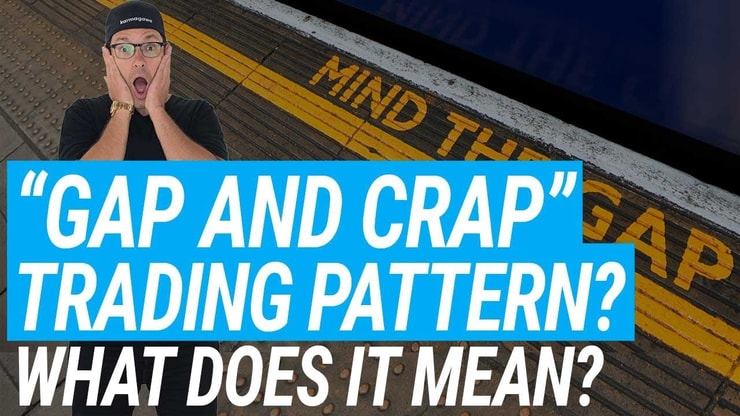The concept of a Fair Value Gap (FVG) offers traders and investors a nuanced view of market imbalances and price movements. As gaps in price levels that haven’t been traded, they highlight areas where liquidity was missing, providing insights into potential future market movements.
Understanding these gaps is crucial for making informed trading decisions and optimizing trading strategies.
I’ll answer the following questions:
- What is a Fair Value Gap?
- How does a Fair Value Gap form?
- What does a Fair Value Gap on a chart tell you?
- How can one identify a Fair Value Gap on trading charts?
- Which timeframe is best to trade the Fair Value Gap?
- What strategies are most effective for trading Fair Value Gaps?
- Can trading with Fair Value Gaps be consistently profitable?
- How do you manage risks when trading Fair Value Gaps?
Let’s get to the content!
Table of Contents
- 1 What Is a Fair Value Gap?
- 2 How to Identify Fair Value Gaps
- 3 Strategies to Trade Fair Value Gaps (FVGs)
- 4 How to Manage Risks When Trading Fair Value Gaps
- 5 Key Takeaways
- 6 Frequently Asked Questions
- 6.1 How Can One Identify a Fair Value Gap on Trading Charts?
- 6.2 What Strategies Are Most Effective for Trading Fair Value Gaps?
- 6.3 Can Trading With Fair Value Gaps Be Consistently Profitable?
- 6.4 What Factors Impact Trading Opportunities?
- 6.5 How Do Investment Theories Apply to Portfolios?
- 6.6 What Is the Role of Content in Investment Advice?
- 6.7 How Do Factors Like Uncertainty and Market Pressures Affect Profits?
- 6.8 How Do Trading Opportunities Arise from Market Inefficiencies?
- 6.9 What Role Does Consciousness Play in Perceiving Trading Risks and Benefits?
- 6.10 Can the Idea of ‘Nothing’ Influence Market Results?
What Is a Fair Value Gap?

2025 Millionaire Media, LLCA Fair Value Gap represents a price range in a chart where no trades were executed, often indicating a rapid price movement over a very short period. These gaps differ from other market gaps primarily in their relationship with market liquidity and trading volume.
- Traditional Gaps: Occur between two trading periods with different opening and closing prices.
- Breakaway Gaps: Signal the start of a new trend.
- Exhaustion Gaps: Indicate the end of a price pattern.
- Fair Value Gaps: Specifically show areas where price has skipped over, creating a void.
What Does a Fair Value Gap on a Chart Tell You?
Identifying a Fair Value Gap can provide critical information about potential market directions and imbalances. It serves as a window into the forces of supply and demand that drive market prices.
- A gap may indicate a strong buying or selling pressure that could lead to significant trend developments.
- Signals include accelerated market entry points or potential reversal zones as the market may return to ‘fill’ the gap.
You should always look for trend confirmation. The ADX indicator helps confirm the strength of the trends associated with these gaps, providing a dual-layer of analytical depth to your trading approach. This combination allows for more precise entries and better-managed exits in volatile markets. Learn how to utilize this method effectively by reading our breakdown on ADX Indicator Strategy.
How to Identify Fair Value Gaps
Recognizing Fair Value Gaps involves a keen eye on price charts and an understanding of market dynamics.
- Tools: Candlestick charts, volume indicators, and liquidity maps.
- Indicators: Chart patterns and historical price levels.
Steps to spotting Fair Value Gaps:
- Review the historical price chart for sudden movements without trading between ranges.
- Identify the start and end points of the gap on the price axis.
- Monitor the volume and price action before and after the gap to assess its significance.
You’ll need a good trading platform to use this indicator…
When it comes to trading platforms, StocksToTrade is first on my list. It’s a powerful day and swing trading platform that integrates with most major brokers. I helped to design it, which means it has all the trading indicators, news sources, and stock screening capabilities that traders like me look for in a platform.
Grab your 14-day StocksToTrade trial today — it’s only $7!
How Does a Fair Value Gap Form?
Fair Value Gaps are typically formed due to sudden market news, drastic changes in market sentiment, or large orders that surpass the current liquidity at a given price level.
A company’s unexpected earnings announcement or major geopolitical events impacting liquidity and causing price jumps.
More Breaking News
- XPeng Navigates Market Challenges Amidst Strategic Shifts
- Outlook Therapeutics’ FDA Resubmission Sparks Interest
- Celcuity Stock Soars on Positive Phase 3 Trial Data for Gedatolisib
- Future of HIVE: Rising or Sinking?
Which Timeframe Is Best to Trade the Fair Value Gap?
Trading Fair Value Gaps can be effective across various timeframes, but the choice depends on the trader’s strategy and market conditions.
The most effective timeframe for trading FVGs often aligns with higher liquidity periods such as the opening and closing times of major markets, where gaps are more likely to be ‘filled’.
Strategies to Trade Fair Value Gaps (FVGs)

2025 Millionaire Media, LLCDeveloping specific strategies for trading around Fair Value Gaps can significantly enhance trade outcomes.
Incorporating Contracts for Difference (CFDs) can enhance strategies around Fair Value Gaps by allowing traders to speculate on price movements without owning the underlying assets. This flexibility is particularly useful when trading on gap movements, as CFDs provide both long and short positioning options with leverage. Explore how to strategically use CFDs by visiting our article on CFD Stocks.
Shorting the Gap
Shorting a Fair Value Gap involves anticipating that the gap will close as prices return to their pre-gap levels.
Steps to short a Fair Value Gap:
- Confirm the presence of a gap with no subsequent immediate filling.
- Enter a short position at the current price level, expecting the price to decline.
- Set a target exit point at or near the beginning of the gap.
Buying the Gap
Conversely, buying into a Fair Value Gap focuses on the possibility of continued momentum away from the gap.
Steps to buy into a Fair Value Gap:
- Identify a gap with strong upward momentum.
- Enter a buy position if the price action suggests continuing upward movement.
- Set profit targets above the upper limit of the gap, anticipating further rises.
Using FVGs as Support and Resistance
Fair Value Gaps can act as dynamic areas of support or resistance, guiding trading decisions.
Trading using FVGs involves setting entries and exits around these key levels, utilizing gaps as barriers that prices might test but not readily surpass.
How to Manage Risks When Trading Fair Value Gaps
Effective risk management is crucial when trading around Fair Value Gaps due to their inherent unpredictability and potential for rapid price movements.
- Risk Management Techniques: Utilization of stop-loss orders, appropriate position sizing, and ongoing market analysis.
A sound arbitrage trading strategy can also help reduce Fair Value Gap trading risks. Arbitrage involves exploiting price differences between markets or instruments, and understanding FVGs can highlight such opportunities. This approach combines the precision of gap analysis with the efficiency of arbitrage to maximize returns. To learn more about blending these techniques for robust trading strategies, check out our guide on Arbitrage Trading Strategy.
Key Takeaways

2025 Millionaire Media, LLC- Fair Value Gaps offer critical insights: Understanding Fair Value Gaps provides a significant advantage by highlighting price levels without trades, revealing potential market imbalances.
- Effective for strategic entry and exit: Fair Value Gaps can guide traders on the best moments to enter or exit trades, particularly around these untested price levels.
- Risk management is crucial: Employing proper risk management techniques, such as using stop-loss orders and correct position sizing, is vital when trading around Fair Value Gaps due to potential volatility.
- Continuous monitoring and adaptation needed: Sustained profitability in trading Fair Value Gaps requires ongoing analysis and adaptation of strategies to align with market conditions and liquidity changes.
Trading isn’t rocket science. It’s a skill you build and work on like any other. Trading has changed my life, and I think this way of life should be open to more people…
I’ve built my Trading Challenge to pass on the things I had to learn for myself. It’s the kind of community that I wish I had when I was starting out.
We don’t accept everyone. If you’re up for the challenge — I want to hear from you.
Apply to the Trading Challenge here.
Trading is a battlefield. The more knowledge you have, the better prepared you’ll be.
Are Fair Value Gaps on your radar? Write “I’ll keep it simple Tim!” in the comments if you picked up on my trading philosophy!
Frequently Asked Questions
How Can One Identify a Fair Value Gap on Trading Charts?
Fair Value Gaps appear as empty spaces on candlestick charts where the price jumps over a range without any trades occurring. These are often accompanied by high volatility and market news.
What Strategies Are Most Effective for Trading Fair Value Gaps?
Effective strategies include trading on the expectation of a gap being filled (shorting) or continuing in the direction of the gap (buying), both supported by sound risk management practices.
Can Trading With Fair Value Gaps Be Consistently Profitable?
While trading Fair Value Gaps offers opportunities for profit, consistency depends on the trader’s ability to manage risks and adapt strategies to changing market conditions. Continuous learning and strategy refinement are key to sustaining profitability.
What Factors Impact Trading Opportunities?
Factors such as liquidity voids, market inefficiencies, and the prevailing uptrend or downside can significantly impact trading opportunities. Investors must consider these alongside fundamentals and technical analysis to identify potential exit points and maximize gains. Awareness of market conditions and proper due diligence are essential in strategizing effectively.
How Do Investment Theories Apply to Portfolios?
Investment theories provide a framework for managing portfolios that might include derivatives, futures, and hedging strategies. These theories help in understanding correlations between different investment types and techniques for speculation. Applying these principles involves continuous research and reevaluation of the investment purpose and fundamentals.
What Is the Role of Content in Investment Advice?
Blogs, articles, and posts play a crucial role in disseminating investment advice, providing examples and case scenarios that help investors understand complex concepts. This content often emphasizes the importance of due diligence and the basic principles of investment, which guide users in making informed decisions amid market uncertainties.
How Do Factors Like Uncertainty and Market Pressures Affect Profits?
Uncertainty and market pressures can lead to significant losses or gains, depending on how they are managed. Factors such as speculation, the efficiency of hedging strategies, and the liquidity of investment portfolios all contribute to the final outcome. Investors must maintain caution and employ rigorous research to navigate these challenges effectively.
How Do Trading Opportunities Arise from Market Inefficiencies?
Trading opportunities often arise from market inefficiencies, where price action traders identify the potential for an upside. The theory behind this is rooted in the basics of supply and demand, where inefficiencies occur when there’s a divergence between a security’s price and its intrinsic value. By raising awareness and shifting perception of the value, traders can capitalize on these opportunities for profit.
What Role Does Consciousness Play in Perceiving Trading Risks and Benefits?
Consciousness in trading involves being aware of the underlying causes and reasons that affect market movements and the reality of investment risks. Traders who maintain a heightened state of awareness are better equipped to perceive opportunities and weigh the potential benefits against possible losses. This acute consciousness helps in making more informed decisions based on the current market existence and potential scenarios.
Can the Idea of ‘Nothing’ Influence Market Results?
In market theory, the concept of ‘nothing’—or zero influence from external changes—can significantly impact results and opportunities. This idea examines how absence or non-action can result in certain market behaviors and outcomes. For instance, a lack of response to a major economic event might cause unexpected stability or volatility, illustrating how non-reaction itself can serve as a powerful cause in trading dynamics.












Leave a reply